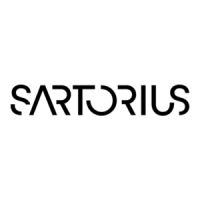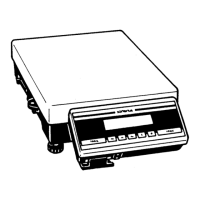Do you have a question about the Sartorius BP 3100 S-0CE and is the answer not in the manual?
Provides an overview of the installation and operating instructions for Sartorius balances.
Details the process for registering the product warranty and its benefits.
Specifies allowable storage temperatures and essential handling procedures for safe transport.
Guidelines for selecting a suitable location and environmental factors for balance setup.
Steps for connecting the electronics box and preparing weighing chambers.
Instructions for connecting the balance to AC power and preparing balance weighing pans.
Covers voltage selection, safety precautions, and handling radio frequency interference.
Details connecting electronic peripherals, adjusting display units, and weighing electrostatically charged samples.
Guidance on leveling the balance accurately using the integrated level indicator.
Covers balance warmup time, turning the display on/off, and the automatic self-test procedure.
Instructions for taring the balance to zero and performing basic weight measurements.
Details the internal calibration process, including menu code selection and activation steps.
Explains how to perform external calibration and unlock the menu access switch.
Covers calibration test procedures, blocking functions, and using the interface port.
Describes how to perform below-balance weighing and secure the balance with an antitheft device.
Lists common issues encountered with Sartorius balances, their causes, and recommended solutions.
Provides instructions for professional servicing, proper cleaning methods, and safety inspection of the balance.
Explains how to navigate and change menu code settings for balance configuration.
Step-by-step guide for accessing a specific menu code (8 5 4) and confirming settings.
Covers understanding current code settings, exiting menus, and using the reset function.
Details how to adapt the balance to prevailing ambient conditions for optimal weighing accuracy.
Defines settings for tare operation timing and the auto zero tracking function.
Explains how to switch between two different weighing units using the F key.
Options for selecting display modes and rounding factors to match accuracy requirements.
Settings for baud rate, parity, stop bits, and handshake mode for data communication.
Defines parameters for data output, including print requests, auto print, and intervals.
Covers automatic taring, outputting application parameters, and using data ID codes.
Details menu access switch functions and methods for blocking balance keys.
Explains connecting an external switch for remote control and configuring power-on modes.
Describes the Tare Memory application program and provides a practical example.
Demonstrates calculating net total weight, showing tare, net, and gross weight outputs.
Explains how to obtain weight readings as a percentage of a reference weight.
Covers changing the reference percentage and configuring display parameters for percent readouts.
Provides a practical example for determining residual weight in percent, including dry weight calculation.
Describes the counting program, changing reference sample quantity, and storage parameters.
Demonstrates the process for counting bulk quantities of items with the same weight.
Explains the animal weighing program, manual/automatic start modes, and subweighing operations.
Details delayed start modes and methods for changing the number of subweighing operations.
Example of automatic animal weighing, including start modes and storage threshold requirements.
Details how to select ISO/GLP printout modes and important notes for compliance.
Explains the format of printouts generated for adjustment, calibration, and linearization functions.
Steps for generating ISO/GLP compliant data records, including outputting heading and additional data.
Includes reference data and parameters in printouts/records for various application programs.
Provides an overview of the balance interface and guidelines for connecting peripheral devices.
Summarizes key interface specifications including type, mode, handshake, and transmission rates.
Details the data block format for 16-character output, including character definitions and spaces.
Explains the special status-dependent and error-dependent codes output by the balance.
Describes the structure of data output with an ID code, including character shifts and ID comments.
Details the format for control commands, including character transmission and command examples.
Lists control commands using upper-case letters or special characters for various balance functions.
Details control commands using lower-case letters to activate specific balance functions.
Explains handshake methods and data transmission parameters for communication.
Describes how to activate data output via print commands or automatically, including higher output rates.
Provides a detailed pin assignment chart for the RS-232 interface connector.
Illustrates the cabling diagram for interfacing a computer or peripheral device via RS-232C/V24.
Lists the technical specifications for Sartorius BP 211 D and BP 301 S balance models.
Details specifications for Sartorius balances with EC Type Approval, including accuracy classes.
Information regarding the EC Type Approval Certificate issued by the PTB.
Lists optional accessories for Sartorius balances, such as data printers and remote displays, with order numbers.
Details data transfer software programs and external calibration weights available for Sartorius balances.
Lists industrial-grade power supplies, density determination sets, and other optional accessories.
Explains the CE mark, its meaning, and compliance with directives like Electromagnetic Compatibility.
Covers operator responsibilities, electrical safety directives, and legal metrology regulations.
Formal declaration of conformity for weighing instruments, listing models and EC Type-Approval Certificates.
Details Sartorius's EC verification services for ensuring legal metrological compliance.
Information on the validity of verifications in European countries and where to obtain further details.
| Maximum Capacity | 3100 g |
|---|---|
| Readability | 0.01 g |
| Calibration | External |
| Display | LCD |
| Linearity | ± 0.02 g |
| Interface | RS-232 |
| Power Supply | AC Adapter / Battery |
| Stabilization Time (typical) | 2 seconds |











